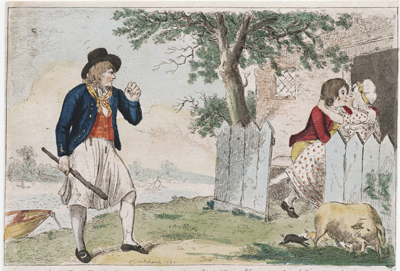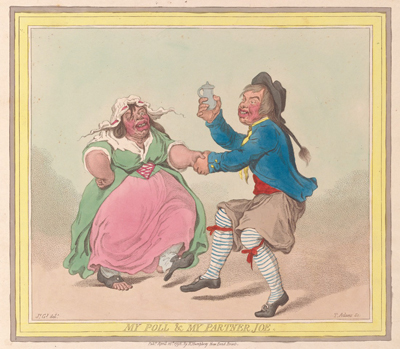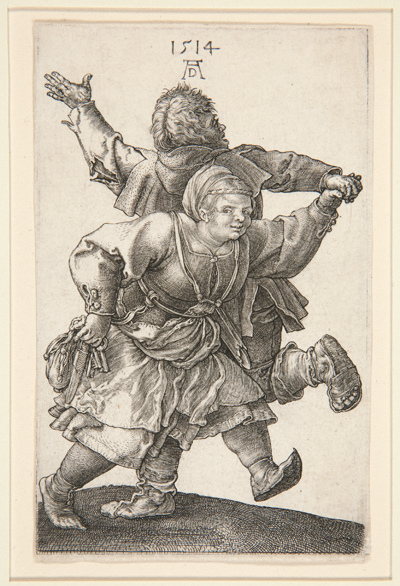My Poll & My Partner Joe
Gillray's My Poll and My Partner Joe borrows its title (but little else) from a popular comic song of the same name by Charles Dibdin. The song is sung by a waterman on the Thames, proud of the life he's created for himself with a snug cottage, a "grunter in the stye," a healthy supply of liquor, a wife, Poll, and a partner, Joe. Into this ideal life steps a press gang which takes the waterman off to foreign parts. But, alas, after doing his duty on the billowing main "in climes afar," he comes home to find "my friend and wife/ Lock'd in each other's arms."
Yet fancy not
I bore my lot
Tame, like a lubber—no;
For seeing I was foully trick'd
Plump to the devil I fairly kick'd
My Poll and my Partner Joe.
In 1790, Isaac Cruikshank had created what could fairly be described as an illustration of the penultimate scene of the song as part of a broadside. The waterman, now a sailor, returns to his snug cottage by the river and to his (apparently) prolific grunter, only to find his wife in the arms of his partner. His clenched fist and firm grip on his truncheon foretells his imminent revenge.

My Poll & My Partner Joe [Aug. 4, 1790]
© Lewis Walpole Library, Yale University
As often happens when Gillray approaches a subject that has already been attempted by another caricaturist, his take on it could not be more different.

© Beinecke Rare Book and Manuscript Library, Yale University
Gone are any of the details from the song: the background Thames, the cottage, the sow. Indeed there is no context or background for the figures at all. Assuming that the two figures are, as the title suggests, my Poll and my partner Joe, we are now in the position of the waterman, discovering them joined, not in an embrace, but in an awkward and drunken dance that reminds one of Durer's Peasants Dancing.

Peasants Dancing [1514]
©Yale University Art Gallery
But what is perhaps most striking about Gillray's print is the combination of the purposely grotesque and ugly figures treated with delicate and precise stippling to create the shading of a fine watercolour. This seems to have been an experiment Gillray was making at this time for the print Cymon and Iphigenia produced two weeks later also combines grotesque figures treated with suprising delicacy. Both are listed as "sculpted" by T. Adams which most commentators believe is simply another alias for Gillray. But if so, it does suggest that the two prints were linked in his mind.
Sources and Reading
- Commentary from the British Museum on My Poll & My Partner Joe
- "My Poll and My Partner Joe," Diprose's Standard Song Book and Reciter
- Thomas Wright and R.H. Evans, Historical and Descriptive Account of the Caricatures of James Gillray #420
Comments & Corrections
NOTE: Comments and/or corrections are always appreciated. To make that easier, I have included a form below that you can use. I promise never to share any of the info provided without your express permission.